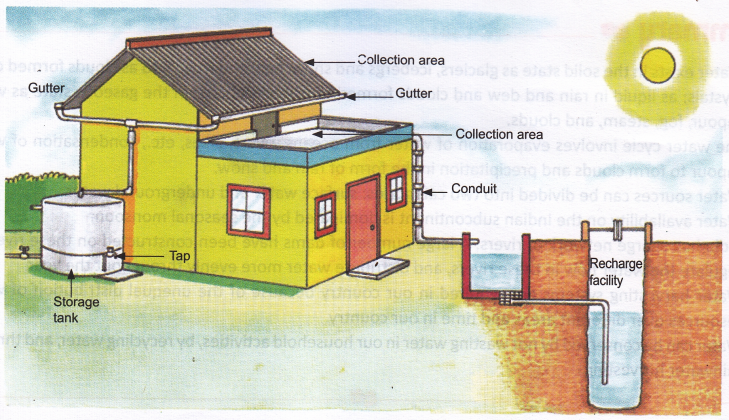Conservation Of Water
India is still not in the ‘water stressed’ category but the day is not far when we will be facing a water crisis. We need to think of various ways to strictly avoid wastage. Since only a small percentage of water on our planet is usable, it is very important that we use water carefully. Conservation of water can be done by building dams, avoiding wastage of water at homes, both indoors and outdoors, harvesting rainwater, and preventing pollution of water. To prevent further shortages, households, communities, and private industries can adopt water saving practices, some of which are given below.
Households can save water by promptly fixing leaks or dripping taps: Although the water lost from leaks may not seem like much, it adds up to quite a lot. A dripping tap can result in a loss of upto 72 litres of water every day.
Recycling of water is very important: We can start this even in our homes. For example, water used in cleaning utensils can be used to water plants in the garden instead of being poured down the drain.
A lot of water is lost during floods: Dams, reservoirs, and embankments will help to check floods and the flow of water.

By improving the methods of irrigating the fields: Instead of filling up the entire field with water, farmers can be taught the method of watering the roots of plants drop by drop. Israel, which is a water-scarce country, has come up with this innovative technique called drip irrigation. This type of irrigation employs the method of watering the roots of the plants drop by drop. This saves up to one-third of the water that would otherwise be lost during spray applications. Further, it enables farmers to double harvests using the same amount of water. In other countries, such as Egypt, some solutions suggested are improvements in water efficiency and moving away from water-intensive crops.

Building Dam
A dam is a structure built to hold back water in order to prevent floods, and to provide water for irrigation and storage. Building a dam is a solution to both drought and flood. Dams are also used in producing electricity. Built on rivers, a dam has high walls and has many openings or gates to both let in and hold back water. During heavy rainfall, when the rivers fill up, water enters the dam. When water is needed later, the gates are opened to let out water.

Preventing Water Pollution
Another method to conserve water is to safeguard our fresh water bodies from pollution. Garbage and harmful chemicals pollute the water and make it unfit for use. Polluted water is also very bad for aquatic life. Plants and animals in and around polluted water may die or get infected. And when human beings consume the contaminated fish, etc., they are also put at risk of diseases.

Avoiding Wastage at Homes
Some ways to avoid wastage of water at homes are given below.
- Inform the municipality or call a plumber if you spot any leaking pipes in your neighbourhood.
- Take water in a bucket for your bath instead of using the shower. A bath in a tub uses the largest amount of water. Always remember to shut the tap tight after each use.
- Do not leave a tap running while brushing your teeth.
- Instead of using running water for washing utensils, soak them first in one tub or sink and wash them in another, using a thin trickle only to rinse off.
- Use a wet cloth to clean the car instead of using a hose.
- Water plants and grass early in the morning so that the water gets absorbed before the sun evaporates it. Watering by hand saves a lot of water as against using a hose.
- Repair all leaky pipes and taps.
- Try not to throw away used or extra water down the drain if it can be used for some other purpose, e.g., you could use water remaining in your water bottle to water the plants.
Rainwater Harvesting Systems
The process of collecting and storing rainwater from roofs or a surface catchment is called rainwater harvesting. Storing rainwater that collects on roofs instead of letting it go down the drain, is a practical solution in case of droughts. This technique is known as rooftop rainwater harvesting. This involves collecting rainwater from rooftops in dugout ponds, vessels, or underground tanks to store water for long periods. Another option is to allow water to go into the ground directly from the roadside drains that collect rainwater. The stored rainwater is treated before use because it may contain bird faeces, chemicals, and other pollutants, which need to be removed before use.
These help us to use rainwater directly. These structures are designed to help capture and store rainwater during the monsoon season, and serve as a source of drinking and irrigation water during the rest of the year.

In the southern states of India, tanks, artificial ponds, and reservoirs have been constructed as part of the water harvesting system. These do not make a significant contribution to the total freshwater resource in India, but water harvesting systems have a strong impact on a local scale.
